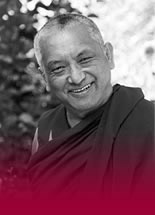Travel Blogs
1 January, 2016 | France
On December 3 I flew to Cyprus, arriving in Larnaca and then driving to Nicosia. First time there! I’d met Dino Joachim, who runs Thab She Ling there, in London in 2014 and he suggested I come. I had no idea where it was, but when I Googled it I discovered it was just an hour away from Amman in Jordan, which is where I begin and end my round-the-world tickets, so a quick round trip before I launched into my 2016 ticket was easy.
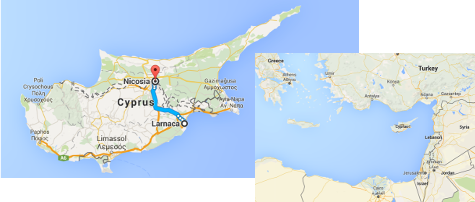
The only thing I knew about Cyprus is that when I lived in the UK it was a popular holiday destination.
It’s part of the European Union and is in the eastern Mediterranean, but being north of Egypt, northwest of Israel and Joran, west of Lebanon and Syria and south of Turkey, it’s virtually in the Middle East. It’s got a pretty tumultuous history – just like its neighbors!
According to Wikipedia, it “was placed under British administration in 1878 and formally annexed by Britain in 1914. Even though Turkish Cypriots made up only 18% of the population, the partition of Cyprus and creation of a Turkish state in the north became a policy of Turkish Cypriot leaders and Turkey in the 1950s. Turkish leaders for a period advocated the annexation of Cyprus to Turkey; while since the 19th century, the majority Greek Cypriot population and its Orthodox church had been pursuing union with Greece, which became a Greek national policy in the 1950s. Following nationalist violence in the 1950s, Cyprus was granted independence in 1960. In 1963, the 11-year intercommunal violence between Greek Cypriots and Turkish Cypriots started, which displaced more than 25,000 Turkish Cypriots and brought the end of Turkish Cypriot representation in the republic. On 15 July 1974, a coup d’état was staged by Greek Cypriot nationalists and elements of the Greek military junta in an attempt at incorporating Cyprus into Greece. This action precipitated the Turkish invasion of Cyprus, which led to the capture of the present-day territory of Northern Cyprus the following month, after a ceasefire collapsed, and the displacement of over 150,000 Greek Cypriots and 50,000 Turkish Cypriots. A separate Turkish Cypriot state in the north was established in 1983. These events and the resulting political situation are matters of a continuing dispute.”
The FPMT group is in the south, where the Greeks are. Dino’s family has lived there for generations. Because of its past history with the UK, English is common. In fact, Dino lives mainly in the UK. You fly in at Larnaca and we had the course at a yoga center in Nicosia. Most of the people who came to the course were Greek Cypriots, except for one woman, Miriam, who’s very devoted to Lama Yeshe. As she said, after reading some tributes to Lama, “Just like they were saying in the tributes, our dear Lama Yeshe’s love – a mother and father's love at the same time.” I stayed with Dino’s mum.
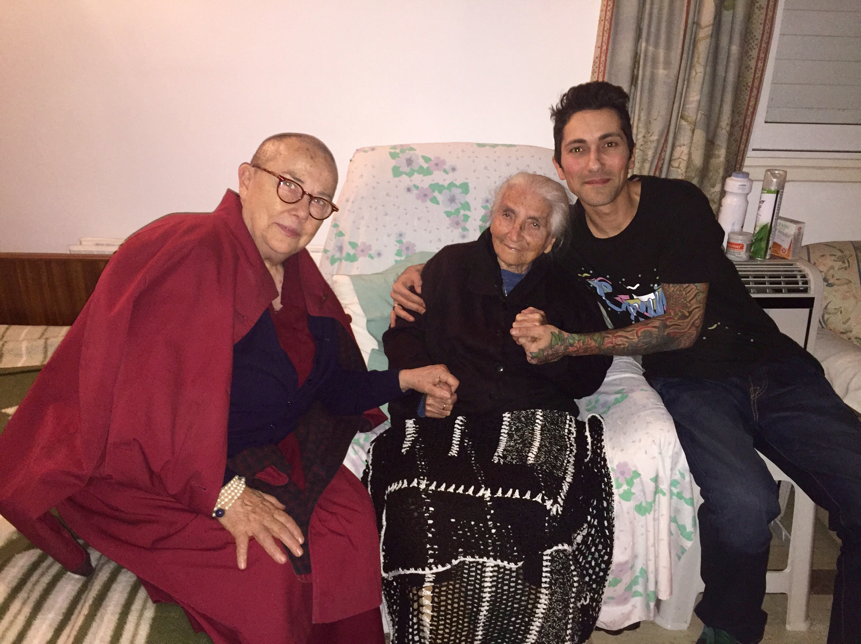
With Dino and his 101-year-old paternal grandmother.
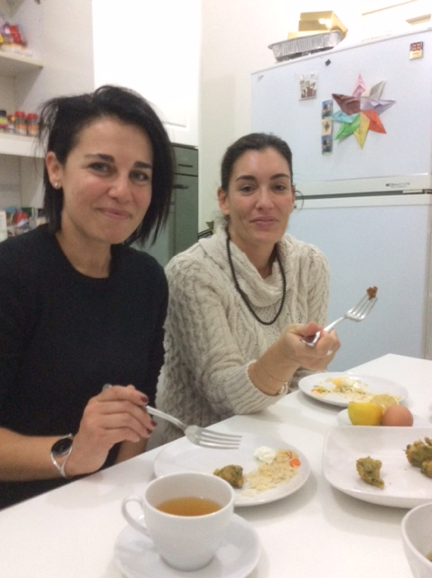
Sunday evening dinner with Turkish-Cypriot Miriam, left, and Greek-Cypriot Alexia, both students of Thab She Ling Study Group.
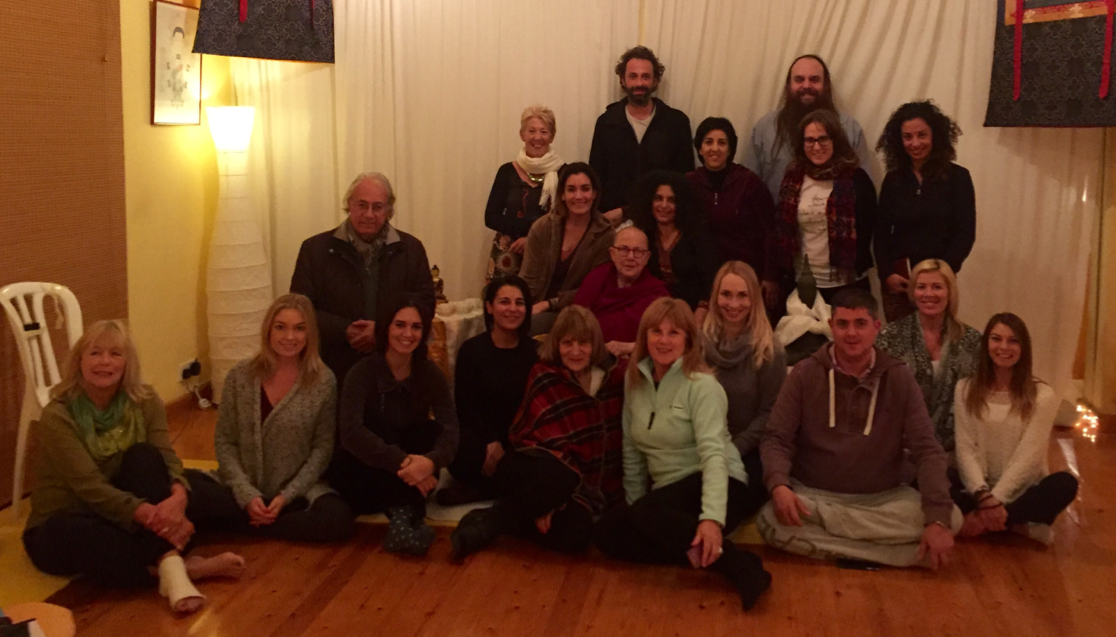
After our weekend together at Marina’s yoga center in Nicosia.
--------
Back to Amman on Monday and on to London. I had a holiday in the countryside of Surrey: very pleasant and peaceful for two weeks, and on my own – I hardly talked at all. Well, there were other people there but I spent most of my time in my room. The countryside was lovely and I could see outside my French doors the other people takings walks, but I didn’t take any, not one. It doesn’t appeal to me. I’m happy it’s there, I just don’t need to walk in it.
I met a nice osteopath in Surrey; he was very helpful. I go to various kinds of body people on my travels. I don’t get sick often but I always appreciate someone who can help me maintain my body. I don’t mind what system they use, as long as the person knows what they’re doing. Edward wasn’t bad at all.
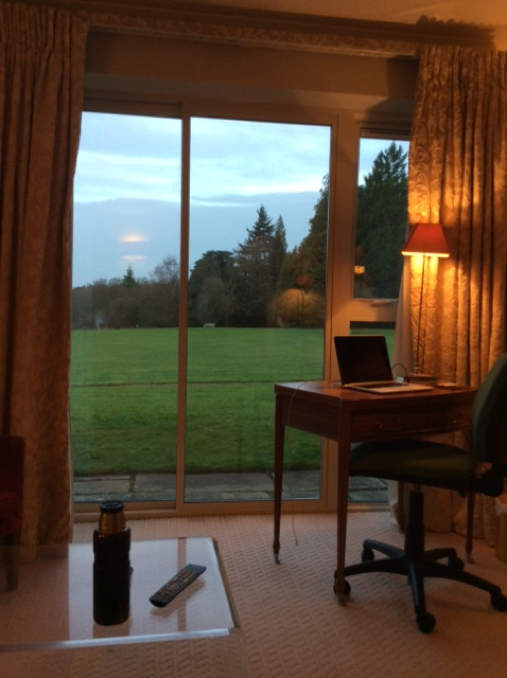
My cosy room in Surrey.
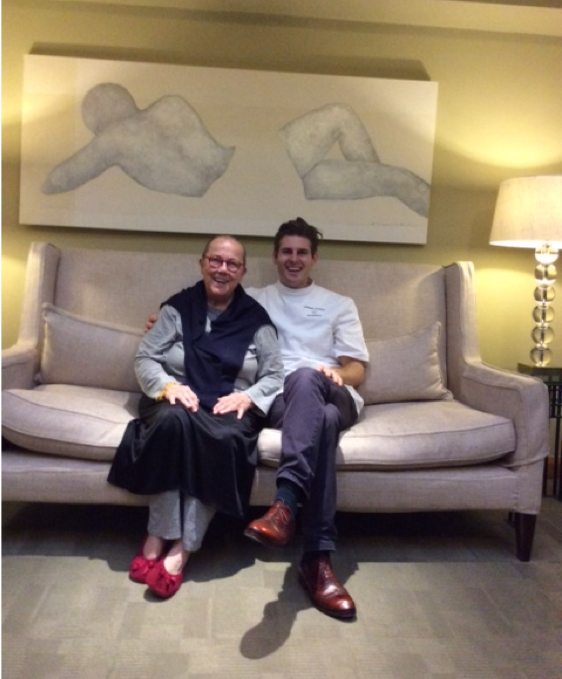
With Edward the osteo – me in my pajamas!
I did some work on Lama’s book on Mahamudra – now Rinpoche’s death book is finished, I can get back to this one. It’s a beautiful teaching, so tasty, so experiential, which of course is Lama’s style. It was given at Atisha Centre in Australia in 1981. Here’s an excerpt from it:
With much contemplation without distraction, we investigate the opposite of mahamudra wisdom – the ego’s concepts, the wrong views of ego. From a clean clear state, without unclear thoughts, investigate. Because if we don’t understand the concepts of ego, how it projects hallucinations onto reality, then our mahamudra meditation becomes Mickey Mouse.
In his root text, the Panchen Lama says that we have to be like a fish moving through water: “While in a state of total absorption as before, and like a tiny fish flashing about in a lucid pond and not disturbing it, intelligently inspect the self-nature of the person who is meditating.”
When you have achieved a level of concentration that you are satisfied with, you use a little bit of analytical wisdom to observe the dualistic view. Keep the awareness of your consciousness, but at the same time you want a subtle part of your mind to check out the ego, whether it’s existent or not.
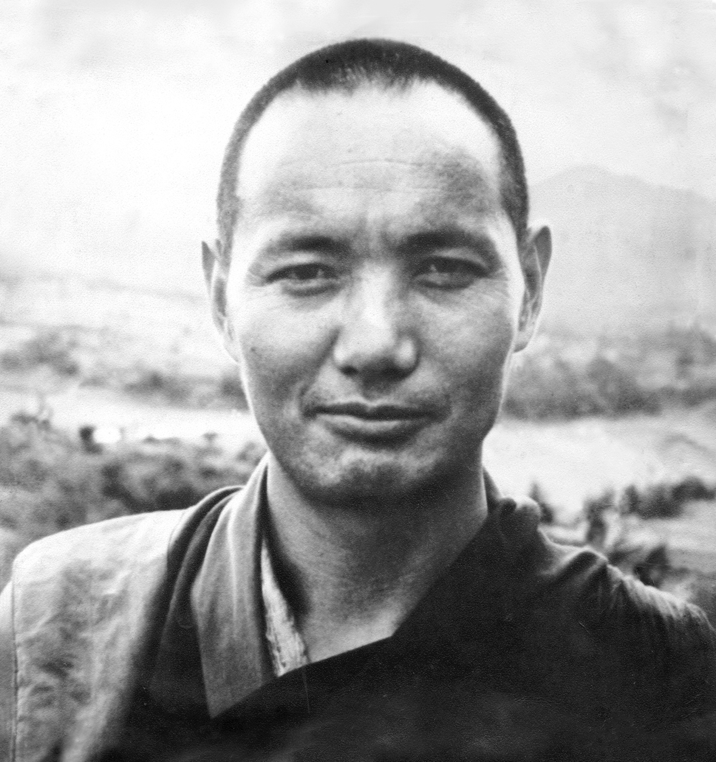
What I’m saying is this: the main meditation is to develop concentration on your consciousness, but whenever you reach some level of satisfaction – and this is not something I can pinpoint for you, saying it’s exactly this or that – then you use your subtle analytical wisdom to analyze the wrong view, the way the ego holds its nonsense, its particular characteristics, the concepts that are the opposite of the wisdom of mahamudra. When you lose that satisfaction, when the concentration goes down a little, you stop the analytical, intellectual checking.
This is Lama’s Tsong Khapa’s tradition for developing mahamudra: unifying the indestructible nature of meditation on the consciousness with the subtle wisdom that analyzes the dualistic view. This is the way to develop insight (vipassana). In Tibetan we call it “lhak-tong.” Lhak means “extra,” tong means “see.” We can interpret “extra” to mean that you see the conventional truth but when you reach a level of insight, you see the universal reality of mahamudra.
First of all we have to understand that our problem is not the intellectual ego. We’re not trying to exchange one view for another. Perhaps you have some conflict with the Buddhist intellectual ego and then you change to the Christian intellectual ego. You can do that, but it’s not dealing with the problem; it does not knock out the root of the ego.
Or let’s say you have studied Buddhism for a long time; I myself have studied for a long time. And then you try to study mahamudra, but it stays as an intellectual trip for you – therefore there’s no transformation. This way you can never get rid of ego. You miss the point. It’s extremely difficult to actualize the teachings; to knock out the ego is a very difficult thing.
In order to really know mahamudra we have to go beyond intellectual study. Even if you know all the Buddhist texts intellectually – and there are many learned professors – you never touch the heart.
I remember when I first studied I thought if I understood all the philosophy, the Madyamika, everything, I’d knock out the ego. I thought about that, I checked, checked, checked; then I realized my conception was not true. I was shocked. People in the monasteries learn all these things. But learning only the words, there is no satisfaction, the problem of ego is not solved.
For the mahamudra teachings to touch our heart we need to develop some real skill. I think it’s actually so simple. Sometimes, I think the Buddhist teachers make it all sound so difficult, even more difficult than samsara, and then you Western people get scared! Life is difficult enough, and now this!
Buddhist philosophy, Madhyamika and the rest, is very sophisticated, very intellectual, involving really complex thinking. But sometimes it takes so much time! I’m not criticizing; it is good. But when we do not touch the heart, all this study seems like a waste of time. This is my point of view. Getting experiences should not be difficult.
I’ve committed to finishing the book later this year. I’d better hurry; even if I have a long life there’s not much of it left.
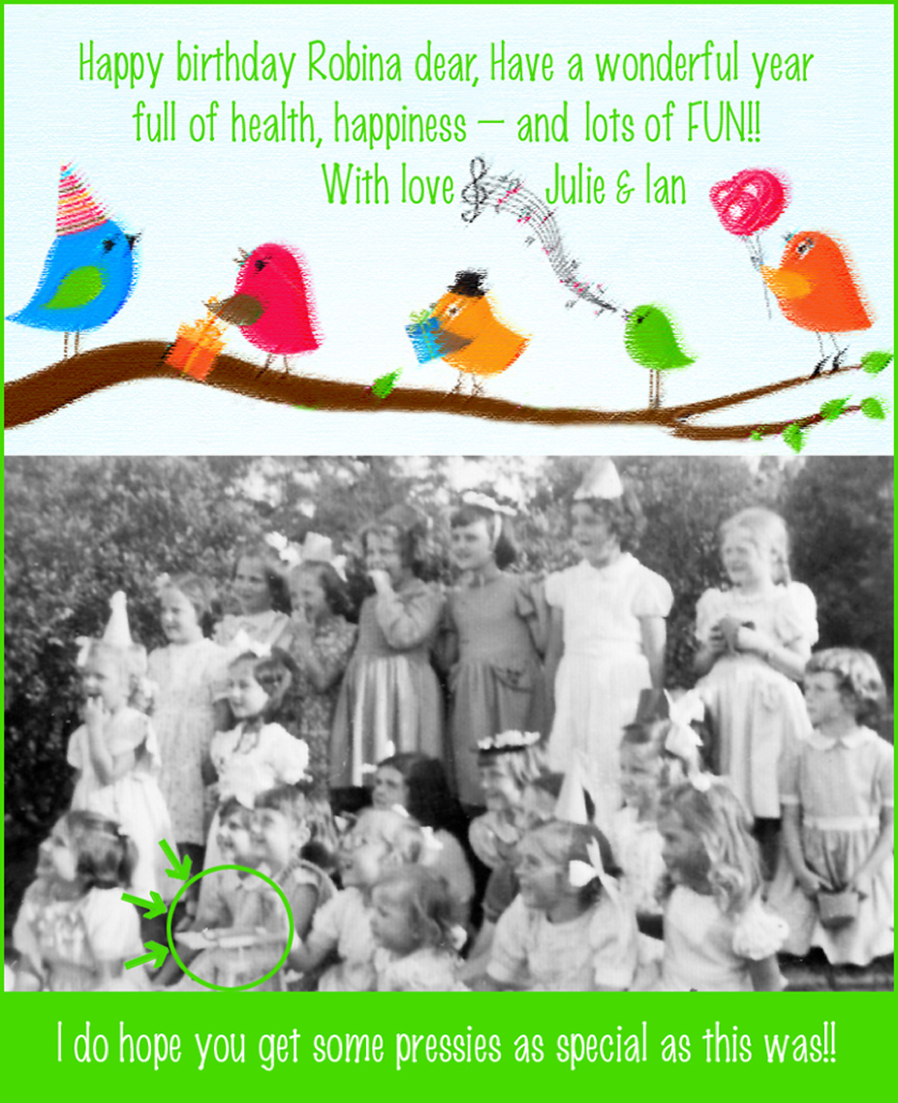
I was reminded of exactly this fact by my 71st birthday occurring during my holiday, December 20. As usual, at least one of my dear sisters sent me a card, this time Julie, who also sent me last year’s. Her comment on the card “I do hope you get some pressies as special as this one” refers to the doll’s high chair that is pointed out that I got for my fifth birthday – that’s me with the glasses next to the chair. I think it was the only birthday party I ever had as a child. I treasured that chair. We were quite poor and there were seven of us so having a lovely thing and, even more, a thing of your own, was rare. My father, a good carpenter, made it. It was a perfect miniature high chair: such lovely detail, bright blue. But not long after my birthday, inevitably it got broken – well, more precisely, I probably broke it – and a piece of it ended up being wedged into our front gate in place of what was supposed to be there. Every time I saw that piece of blue, I felt the loss of that delicious thing.
---------
Then off to France for my visit to Institut Vajra Yogini on December 22 for our annual 8-day retreat, starting after Christmas. The days were lovely, mild and sunny, but sometimes misty.
It’s been years since I had a summer there – a summer anywhere, for that matter. My schedule is such that I get permanent winters: this year, for example: January through March is in the US etc.; April through August, Australia’s winter; September through November: India and Nepal’s spring, I suppose; then December again in France and January through April 2017 in Europe. I don’t mind, actually. I used to love the summers, now not. Actually, I don’t mind any weather!

Violette, who runs the center with Francois, takes all the photos. Their new prayer wheel is on the left, containing some countless billions of mantras.


Above, with director Francois, and below with Matty and Paula de Wys from Amsterdam, at the Insitut Vajra Yogini for the day.
I couldn’t wait to see Peter Iseli and the progress on his amazing 15-meter Twenty-one Taras. He moved in his massive purpose-built studio here three years ago. I forgot to take a photo of him or his Taras this time; below is from two year ago. It’s an astonishing thing to behold! Lama Zopa Rinpoche commissioned it for Tara Institute in Melbourne, I think. In Tibet, they bring out these big paintings on holy days and hang them outside. Next year when I’m in France it’ll be gone.


